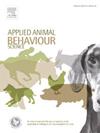3-6个月狗的行为问题聚类反映了潜在的情感共性
IF 2.2
2区 农林科学
Q1 AGRICULTURE, DAIRY & ANIMAL SCIENCE
引用次数: 0
摘要
问题行为倾向于使用“行为方法”来概念化,该方法强调可观察事件和行为之间的偶然性;一种是“医学方法”,强调导致某种形式紊乱的身体变化;另一种是“心理生物学方法”,强调正常情绪控制系统的重要性。心理生物学方法预测,不同的问题行为会聚集在一起,因为一个共同的情感网络影响了它们表达的概率。为了探讨这一点,我们分析了主人报告的小狗行为问题的严重程度,以探索它们之间的直接联系和相关的聚类结构。对狗主人进行了一项横断面调查,询问了21种常见的小狗行为问题的严重程度(4点李克特量表)。在3 - 6个月的幼犬中,我们进行了探索性图分析来估计条件依赖网络和相关的聚类结构。我们发现了四个可以被解释为反映不同情绪网络的集群:激励寻求(DESIRE/ seeking)、厌恶回避(FEAR)、挫折(RAGE)和依恋(PANIC/GRIEF) (sensu Panksepp 1998)。这些结果表明了不同行为问题的潜在共同情绪基础,并通过关注个体行为的情绪控制系统,为管理和修改行为提供了经验支持。本文章由计算机程序翻译,如有差异,请以英文原文为准。
Clustering of behavioural problems in dogs aged 3–6 months reflect underlying emotional commonalities
Problem behaviour tends to be conceptualized using either a “behavioral approach”, which emphasizes the contingency between observable events and behaviour; a “medical approach”, which emphasizes physical changes which give rise to some form of disorder or a “psychobiological approach”, which emphasizes the importance of normal emotional control systems. The psychobiological approach predicts that different problem behaviours will cluster together due to a common emotional network influencing the probability of their expression. To explore this, we analysed owner reported severity of puppy behavioural problems with a view to exploring their direct associations and associated clustering structure. A cross-sectional survey of dog owners was performed asking about the severity (4-point Likert scale) of 21 common puppy behaviour problems. In puppies aged from 3 to 6 months of age, we performed exploratory graph analysis to estimate the conditional dependency network and associated clustering structure. Four clusters were identified which could be interpreted as reflecting different emotional networks: incentive seeking (DESIRE/SEEKING), aversion avoidance (FEAR), frustration (RAGE), and attachment (PANIC/GRIEF) (sensu Panksepp 1998). These results demonstrate a potential common emotional basis to diverse behaviour problems and provide empirical support for managing and modifying behaviour by focussing on addressing emotional control systems over individual behaviours.
求助全文
通过发布文献求助,成功后即可免费获取论文全文。
去求助
来源期刊

Applied Animal Behaviour Science
农林科学-行为科学
CiteScore
4.40
自引率
21.70%
发文量
191
审稿时长
18.1 weeks
期刊介绍:
This journal publishes relevant information on the behaviour of domesticated and utilized animals.
Topics covered include:
-Behaviour of farm, zoo and laboratory animals in relation to animal management and welfare
-Behaviour of companion animals in relation to behavioural problems, for example, in relation to the training of dogs for different purposes, in relation to behavioural problems
-Studies of the behaviour of wild animals when these studies are relevant from an applied perspective, for example in relation to wildlife management, pest management or nature conservation
-Methodological studies within relevant fields
The principal subjects are farm, companion and laboratory animals, including, of course, poultry. The journal also deals with the following animal subjects:
-Those involved in any farming system, e.g. deer, rabbits and fur-bearing animals
-Those in ANY form of confinement, e.g. zoos, safari parks and other forms of display
-Feral animals, and any animal species which impinge on farming operations, e.g. as causes of loss or damage
-Species used for hunting, recreation etc. may also be considered as acceptable subjects in some instances
-Laboratory animals, if the material relates to their behavioural requirements
 求助内容:
求助内容: 应助结果提醒方式:
应助结果提醒方式:


